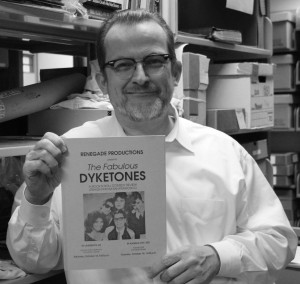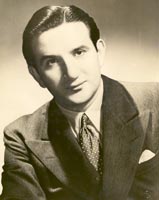 2012 marks the 75th anniversary of the public introduction of Raymond Scott’s music! Find out more about events surrounding this occasion at the Raymond Scott Archives blog. And don’t forget to check out what your very own LaBudde Special Collections has to offer in the Raymond Scott Collection donated by Raymond’s widow, Mitzi in 1993.
2012 marks the 75th anniversary of the public introduction of Raymond Scott’s music! Find out more about events surrounding this occasion at the Raymond Scott Archives blog. And don’t forget to check out what your very own LaBudde Special Collections has to offer in the Raymond Scott Collection donated by Raymond’s widow, Mitzi in 1993.
Author Archives: Sandy Rodriguez
GLAMA Collection featured in UNews
Check out this week’s edition of the University News features a 2-page spread on the Gay and Lesbian Archive of Mid-America! Make sure to pick up a hard copy in the MNL lobby and elsewhere on campus to see featured images of items from the collection. If you prefer the online version, you’ll be missing out on the array of photos.
Stuart Hinds, Director of Special Collections, UMKC Libraries
Good radio
 When J. David Goldin visited UMKC in May 2010, I could not pass up the opportunity to speak with him. He has listened to and annotated thousands upon thousands of hours of historical American radio. He has a passion for radio, as he said in our conversation, “I collected the stuff because I like to listen to it.”
When J. David Goldin visited UMKC in May 2010, I could not pass up the opportunity to speak with him. He has listened to and annotated thousands upon thousands of hours of historical American radio. He has a passion for radio, as he said in our conversation, “I collected the stuff because I like to listen to it.”
There are not many people in the world with his knowledge and exposure to radio. So I decided to ask him the ultimate question:
“What is good radio?”
He replied, “It’s a tough question. How can one put that in words?”
“It makes you use your mind…it actually makes you think about what you are listening to. A lot of people listen to the radio, but don’t really hear it today.”
“Good radio makes you want to listen.”
“What are you looking at when you listen to the radio? It’s one of the few things that you do, where you don’t need your eyes. And so, do you look at the radio receiver, do you look across the room, let your eyes go out of focus? My favorite program would be the kind where you forget your eye completely and just listen with your imagination.”
I asked him to give me some examples of good radio. He said as far as writers, Arch Oboler and Norman Corwin are high on his list. If he was stranded on an island with one radio series it would be the Jack Benny program. He also mentioned a specific play titled The Dark Tower by Louis MacNeice.
“[The Dark Tower] was totally different from anything else I had ever heard before. I would pinpoint that one as the most interesting program that I ever heard. It was totally different then any of my other experiences.”
The radio play is a fantasy about the youngest and last son in a family of many sons. All of the men in his family including the father have gone to fight a dragon and never returned. As he travels toward the dark tower where the dragon lives, he battles with his loyalty to his family’s history and his own personal desires. The story takes him through many magical and metaphysical situations, and has a profound, thrilling ending (you must hear it!).
“Good radio should be intrinsically radio,” Goldin also said. And The Dark Tower is an example of this. It is a play that is so engaging because it plays in the mind in fantastical ways that would be spoiled in a visual medium.
While the actual recording of The Dark Tower is very hard to get a hold of, there is a recording of an interview with its author and Edward R. Murrow and also a disc of MacNeice reading some of his own poetry in the Marr Sound Archives.
Goldin emphasized at one point, “There aren’t that many people interested in creative radio, or radio as an art form. It seems to have gone far away.” But thanks to Goldin and his preservation of so many historical American radio recordings there is a chance for this situation to change. “Good radio” is worth the listening.
Troy Cummings, guest contributor
More memorable moments with the Brush Creek gang!
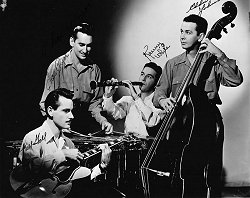 The Brush Creek Follies may have easily been classified as a western rural variety show, and to an extent, that’s exactly what it was. However, quite a few musicians featured on the Brush Creek Follies did not devote their musical abilities exclusively to hillbilly and western music. Such groups as the Midland Minstrels (pictured right), Harvest Hands, Judy Allen, and the Payne Sisters all performed songs that appealed to novelty and popular music crowds. These musicians were incredibly good, especially the multi-talented Charlie Pryor, originally a member of the Midland Minstrels and later affiliated with the Tune Chasers. Listen to an excerpt displaying the versatility of the musicians on the Brush Creek Follies.[audio:http://info.umkc.edu/specialcollections/wp-content/uploads/2011/10/2012-02-13_BrushCreek2_Church_kmbc-785.mp3|titles=Whatcha know Joe]
The Brush Creek Follies may have easily been classified as a western rural variety show, and to an extent, that’s exactly what it was. However, quite a few musicians featured on the Brush Creek Follies did not devote their musical abilities exclusively to hillbilly and western music. Such groups as the Midland Minstrels (pictured right), Harvest Hands, Judy Allen, and the Payne Sisters all performed songs that appealed to novelty and popular music crowds. These musicians were incredibly good, especially the multi-talented Charlie Pryor, originally a member of the Midland Minstrels and later affiliated with the Tune Chasers. Listen to an excerpt displaying the versatility of the musicians on the Brush Creek Follies.[audio:http://info.umkc.edu/specialcollections/wp-content/uploads/2011/10/2012-02-13_BrushCreek2_Church_kmbc-785.mp3|titles=Whatcha know Joe]
In addition to the great musical performances, the show presented familiarity to its listeners with the use of catchphrases by certain cast members. Here are just a few that have been burned into my mind after many hours of listening:
“Well for gosh sakes!” — Scrappy O’Brien, Kenny Carlson’s ventriloquist dummy, would always follow this catchphrase with a laugh and the occasional “Aw, shucks.” The “gosh” part of this catchphrase could last a good five seconds.
“Now cut it out, will ya?!” and “No foolin’…” — “Radio’s original rube” Hiram Higsby always had something clever to say or do during the show. Playing the part of the emcee for the Brush Creek Follies, he also announced most of the performances and was a regular part of the comedy routines, which often included these two catchphrases.
The laugh of Rube Wintersuckle — Think of what it would sound like if while driving, you rolled over a series of bumps while laughing. This is exactly what Rube Wintersuckle’s trademark laugh sounded like. Playing a red-headed hillbilly, Wintersuckle tended to come off as brainless because of his appearance and demeanor, but in the end, he always had the last laugh (no pun intended).
“Oh man…” and “Ain’t you hear?” — Probably the most discriminating and cringe-worthy of all of the Brush Creek catchphrases would be George Washington White and his black-faced comedy routine.
“Timber, timber, timber, timber!” — Similar to the way the Three Stooges harmoniously sang their hellos, Rocky and Rusty always introduced their songs with their own theme song.
“Uncle Charlie!” — Little Mary, a latecomer to the 1941 season, always brought about big laughs from the audience with her high-pitched voice, and we may never know why or what she looked like.
Gabby Tuttle, KMBC Project staff/Liberal Arts (BA) student
For more photos, information, and audio clips on the Brush Creek Follies, visit the Brush Creek Follies web exhibit.
1817 map reveals the growth of a nation
A portrait of our growing nation can be found on the map entitled “Map of the Northern Part of Missouri Territory” dating from around 1817. The war of 1812 had just ended and the country was growing westward into the new territories. The map shows the area around St. Louis well settled and a spray of just created counties spreading westward. Perhaps the map’s most interesting feature is the marking of regions in both Illinois and Missouri as “Military Bounty Lands.” Military Bounty Lands were areas set aside to be given to eligible veterans for their service in the war of 1812. These were created by three different acts passed by Congress on December 24, 1811; January, 11, 1812; and May 6, 1812. Under these acts, non-commissioned officers and soldiers serving for five years, or their heirs, would be entitled to three months pay and 160 acres of public land as compensation for their military service. The map is definitely a snapshot of a young nation growing and expanding.
Garth Tardy, Library Specialist, Special Formats
Celebrating Black History Month: Remembering Where We’ve Been and How Far We Have to Travel
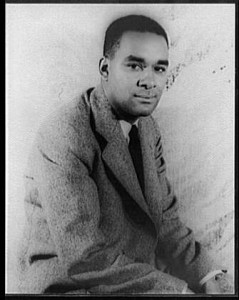 Within the Goldin collection, the political roundtable debates, dramas with social commentary, and panel discussions about real and significant problems, most of which have no answer and are still legitimate problems in America and abroad, are very relevant, despite the age of the recordings.
Within the Goldin collection, the political roundtable debates, dramas with social commentary, and panel discussions about real and significant problems, most of which have no answer and are still legitimate problems in America and abroad, are very relevant, despite the age of the recordings.
There are occasionally discs that will always stand out, such as This is South Africa: South African Problem. The “problem” referred to in the title is the “natural” cultural and developmental differences between indigenous South Africans and white South Africans. As the speaker explains it, racial segregation was necessary to allow particular races to enjoy their own cultural differences; indigenous tribes like the Zulu (there is an interesting, if not completely related, program on polygamy in Zulu society on the reverse of this disc) could continue their traditional ways of life without interference, and Europeans and European descendants were free to abide by their own ways of living. The real and harsh reality is that those justifications are false, almost laughably false if not for the terror they conceal. A point that the speaker stressed throughout was the different technological developments that separated the indigenous ethnic groups from the white South Africans. They never used the phrase, but “separate but equal” sums up his argument. We all know the history of that thinking in our own homeland.
Racial segregation in South Africa had begun during the colonial period, but didn’t become official policy and law until 1948. The South African general election of 1948 which created the system of racial segregation enforced by the National Party government that would later be known as apartheid was held May 26, 1948 and this disc was broadcast Dec. 12, 1948. The proximity of this broadcast to the passage of that law is astounding, and one assumes, a broadcast like this, intended for an international audience (and in this particular case, an American audience) was to present it in a positive light. When this vote was cast in South Africa, Jim Crow laws in the United States, in some form, had been around for over 70 years.
The reverse side of this disc features its own stand-alone program not meant to have any connection to this one, but featured a speaker making a statement about South Africa’s hospitality, weather, and other pleasantries saying, “[T]here’s something very familiar about South Africa to an American, so very much like our own country.” Heard in the context of the entire disc, this statement takes on a very different meaning than it was intended, but is all the more poignant.
Thankfully, there are many more discs in the Goldin collection that feature far more positive and progressive messages. New world a-coming is one outstanding example. This series focuses on many of the problems and challenges faced by racial and ethnic minorities in the US, and several programs focus on African Americans specifically.
Most of the programs focused specifically on discrimination in employment, such as A job for Jane which is about how labor unions are a solution to problems of unemployment and underemployment, and how everyone has the right to fair and equal employment, despite their race or gender; Black boy which is based on the autobiography by Richard Wright (pictured above), follows the difficulties faced by a young African American man trying to get a fair and decent job in the American South; and Color scheme is about a man hired to be the manager of a pharmaceutical factory (we’re to assume he’s white, because it’s never mentioned), who hires an African American to run one of the labs, and the discrimination he faces by his subordinates, as well as the factory’s owner. These dramas, in my opinion, are very impressive programs for 1945-46.
As important as these examples of the message that the American dream is for everyone, they aren’t too far removed from the reality of the time: as Goldin notes on the inventory form for Black boy, the part of the young African American man, Richard Wright, is played by a prominent (white) Jewish actor (although another post in itself, “New pilgrim,” deals with the discrimination faced by Jews in America.) So was the reality of show business in America.
With the risk of continuing this increasing long blog post, let me briefly mention a few other programs of note, Neither free nor equal: The hate merchants is a dramatic-documentary about intolerance and discrimination in the United States, including useful ways to deal with hate mongers. Groups highlighted as being discriminated against include Jews, African Americans, communists, Catholics, and Protestants. A program called Creighton University of the air: Contributions of the colored race to the American heritage is a panel discussion about the contributions of African Americans to American society and takes the stance that greater equality for African Americans will be of benefit to the entire country by allowing more people to be working towards the greater good. Finally, there is a very interesting discussion from a program called In our opinion: The Negro and communism which discusses if communism is a more effective system for African Americans than the current system of capitalism. Whether it was or not is irrelevant when put in the context that this was 1947 and being an American and communist, or the mere appearance of “communist sympathizing” was dangerous for anyone of any background, to say the least.
There are other such programs in this collection, and I’m sure, there will be more to come. For assistance searching the Goldin collection, or any other, you can contact your friendly neighborhood reference librarian or Marr staff.
Anthony Prince, Goldin Project staff
Free up your Friday night or set your TiVo
Do people even have TiVo anymore?…
The Marr Sound Archives is slated to be featured on this Friday’s broadcast of “Michael Feinstein’s American Songbook” on KCPT! In an episode entitled “Time Machines”, Mr. Feinstein will highlight ways in which technology has preserved sound recordings and made them accessible for generations (look for an appearance by Roobot, I’m betting). So have your popcorn popped and your beverages cold for a 9:00 starting time, lean back into the couch cushions, and enjoy!
If you just can’t wait, here’s a preview.
Watch Time Machines on PBS. See more from Michael Feinsteins American Songbook.
Stuart Hinds, Director of Special Collections, UMKC Libraries
Memorable moments with the Brush Creek gang
Come on everybody, get ready to go, this is the Brush Creek Follies show! There’s singing and dancing and fun galore, and maybe if you whoop and holler we will do some more! Saturday night in Kansas City was a night of comedy, singing, dancing, and pure entertainment for the public provided by the local variety show, the Brush Creek Follies. Similar to the Grand Ole Opry, this live radio program showcased western-style musicians, comedians, and the occasional special guest. Thanks to the Arthur B. Church collection available in the Marr Sound Archives, you can have access to the shows that aired in 1941 as well as a select few others.
The 1941 season of BCF was smack dab in the middle of World War II, but you could hardly tell because of the excitement the show brought every Saturday night. Each week, BCF had a theme, which gave the performers a central focus for their weekly material. Some themes were targeted towards a certain population of listeners, such as “Irish night”, “Kid’s night,” or “Couple’s night.” Other themed nights were celebratory, such as the 3rd anniversary of Colorado Pete, a yodeling cowboy. My personal favorite, “Beaver’s night,” entailed all the men not shaving throughout the week, and a contest was even held to find the longest whiskers in the audience. What made the show successful were the performers, who all had extremely devoted fans. Kit and Kay, twin singing cowgirls, were especially popular and often received flowers and gifts from audience members.
The show’s regular performers appealed to all ages: a favorite for the kids was ventriloquist Kenny Carlson and his dummy, Scrappy O’Brien; the older generation could listen to the “Remember Time” segment, in which singing couple, Smokey Parker and Penny Lynn would sing “oldies but goodies;” and you could hear young girls literally swooning over the singing cowboy groups, like the Oklahoma Wranglers and Rocky and Rusty. Of all the acts that I had heard, nothing was quite as original and still mysterious as Little Mary’s comedy skit, often done with BCF co-host, Charlie Napier. What makes Little Mary mysterious is that I haven’t figured out just what she is. I have created this idea that she is either a man dressed up like a little girl or a puppet. All the same, her high-pitched voice and constant antagonizing Napier is very amusing. Click here to listen to an excerpt from the show.[audio:http://info.umkc.edu/specialcollections/wp-content/uploads/2012/01/2012-01-24_BrushCreek1_Church_kmbc-757.mp3|titles=Kenny and Scrappy]
Coming up in the second installment of this two-part Brush Creek Follies special, we will look at some super-talented musicians and the catchphrases that I couldn’t forget if I tried.
Gabby Tuttle, KMBC Project staff/Liberal Arts (BA) student
For more photos, information, and audio clips on the Brush Creek Follies, visit the Brush Creek Follies web exhibit.
Legendary dancer featured in a new exhibit
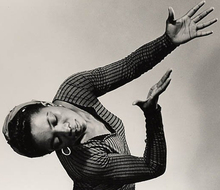 Dancer, choreographer, educator, and anthropologist Pearl Primus is featured in a new Ground Floor exhibit at MNL. “’The Returned Spirit’: Pearl Primus in Africa” features photographs of this amazing mid-20th century dance dynamo during her second trip to the West African nation of Liberia. Her visits to Africa were transformative for her professionally and personally, and the images really capture both her energetic dance style as well as her anthropological curiosity. The pictures in the exhibit are from a 1952 scrapbook in the Leon Jordan Collection; both Jordan and Primus were in Liberia at the same time for the second inauguration of the country’s president. To get a sense of Primus’ phenomenal athletic stage presence, check out this video.
Dancer, choreographer, educator, and anthropologist Pearl Primus is featured in a new Ground Floor exhibit at MNL. “’The Returned Spirit’: Pearl Primus in Africa” features photographs of this amazing mid-20th century dance dynamo during her second trip to the West African nation of Liberia. Her visits to Africa were transformative for her professionally and personally, and the images really capture both her energetic dance style as well as her anthropological curiosity. The pictures in the exhibit are from a 1952 scrapbook in the Leon Jordan Collection; both Jordan and Primus were in Liberia at the same time for the second inauguration of the country’s president. To get a sense of Primus’ phenomenal athletic stage presence, check out this video.
This exhibit is timed to coincide with some upcoming Library programs:
- The 2012 African American Read-In, Feb. 21 (MNL) and Feb 29 (Diastole)
- Stitches: An Exhibit of Textiles by Nedra Bonds, featuring the Women’s Equity Quilt, slated to open on Feb 2 in the Dean’s Gallery, sponsored by the Women’s Center. The opening reception will feature a play with dance accompaniment.
Many thanks to Scott Gipson, LSC Library Information Specialist II, for photo reproduction services and to Conservatory Student Assistant Anthony Rodgers for spontaneous installation assistance.
Enjoy the new exhibit!
Stuart Hinds, Director of Special Collections, UMKC Libraries
Web exhibit receives a makeover
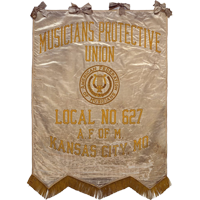 While technically not a new exhibit, the Local No. 627/Mutual Musician’s Foundation online exhibit has been so masterfully reworked that it really is, indeed, a completely new site. Take a few minutes and check it out for yourself!
While technically not a new exhibit, the Local No. 627/Mutual Musician’s Foundation online exhibit has been so masterfully reworked that it really is, indeed, a completely new site. Take a few minutes and check it out for yourself!

